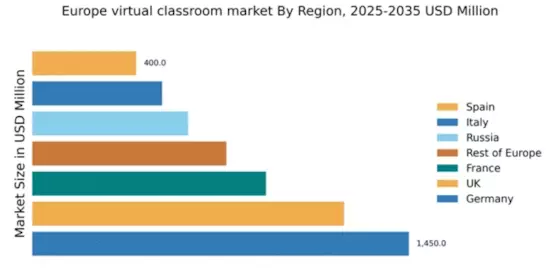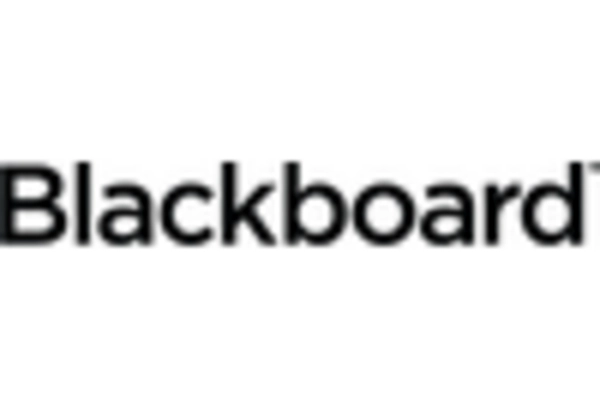Growing Emphasis on Lifelong Learning
The virtual classroom market in Europe is significantly influenced by the growing emphasis on lifelong learning. As the job market evolves, professionals are increasingly seeking opportunities to upskill and reskill through online platforms. Recent statistics suggest that around 70% of employees in Europe are engaging in some form of continuous education, highlighting the demand for accessible learning solutions. This trend is further supported by the rise of industries that require specialized knowledge, prompting organizations to invest in virtual training programs. Consequently, the virtual classroom market is adapting to provide a wide array of courses and certifications that cater to the needs of adult learners. This focus on lifelong learning is likely to drive sustained growth in the sector.
Government Initiatives Supporting E-Learning
In Europe, various government initiatives are actively promoting e-learning, significantly impacting the virtual classroom market. Governments are increasingly recognizing the importance of digital education in enhancing the quality of learning and bridging educational gaps. For instance, funding programs aimed at integrating technology into classrooms have been established, with budgets reaching up to €500 million in some regions. These initiatives not only provide financial support but also encourage collaboration between educational institutions and technology providers. As a result, the virtual classroom market is poised for expansion, as more schools and universities adopt digital platforms to facilitate learning. This governmental backing is likely to foster innovation and improve the overall educational landscape in Europe.
Rising Demand for Flexible Learning Solutions
The virtual classroom market in Europe experiences a notable surge in demand for flexible learning solutions. This trend is driven by the increasing need for personalized education that accommodates diverse learning styles and schedules. As educational institutions and corporate training programs seek to enhance accessibility, the virtual classroom market is adapting to provide tailored experiences. Recent data indicates that approximately 65% of students prefer online learning options that allow them to learn at their own pace. This shift towards flexibility not only caters to individual preferences but also aligns with the evolving workforce requirements, where continuous learning is essential. Consequently, the virtual classroom market is likely to witness sustained growth as it meets the needs of both learners and educators seeking adaptable solutions.
Technological Advancements Enhancing User Experience
Technological advancements play a crucial role in shaping the virtual classroom market in Europe. Innovations such as artificial intelligence, augmented reality, and interactive learning tools are enhancing the overall user experience. These technologies facilitate more engaging and immersive learning environments, which are essential for maintaining student interest and improving retention rates. Data indicates that institutions utilizing advanced technologies in their virtual classrooms report a 30% increase in student engagement. As educational providers continue to integrate these tools, the virtual classroom market is expected to evolve rapidly, offering more dynamic and effective learning experiences. This ongoing technological evolution is likely to attract a broader audience, further expanding the market.
Increased Collaboration Between Educational Institutions and Tech Firms
The virtual classroom market in Europe is witnessing increased collaboration between educational institutions and technology firms. This partnership is driven by the need for innovative solutions that enhance the learning experience. Educational institutions are increasingly seeking to leverage the expertise of tech companies to develop customized platforms that meet their specific needs. Recent trends indicate that over 40% of educational institutions in Europe are engaging in partnerships with technology providers to enhance their digital offerings. This collaboration not only fosters innovation but also ensures that the virtual classroom market remains competitive and responsive to the changing demands of learners. As these partnerships continue to grow, they are likely to contribute to the overall advancement of digital education in Europe.


















Leave a Comment